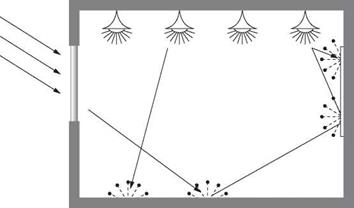The ambient light is basically all light other than the light being directly emitted from the display (Figure 4.13).
Typically, the ambient light level in a control room will be a combination of natural light entering the room from windows, lighting in the ceiling, and the light emanating from the display itself. Depending on the reflectivity of the various surfaces in
|
FIGURE 4.13 Sources of ambient light. |
the room, the resulting ambient light level will be a combination of all these sources. The ambient light level combined with the actual luminances in the field of vision determines the average adaptation level and thus influences the viewer’s perception of the display. Controlling the ambient light is essential for achieving high-quality images. Glare is the most important factor that might impede an operator’s view of the display. Daylight and particularly direct sunlight are extremely powerful compared with artificial lighting, and especially compared with the power of projection systems. Direct sunlight is a negative factor for every type of display.




